From all the countries Gary and I have visited, Iceland has to be one of our firm favourites. In fact, we wouldn’t hesitate to go back. Whichever continent you are from, I promise that you have never seen a place like Iceland before. This island is utterly unique!
I was looking for a location to celebrate Gary’s 30th birthday. That’s when Iceland came to mind – a country that has been on both of our bucket lists for a very long time. If you’re a regular reader of A Life Beautifully Travelled then you know that there aren’t many things that we love more than a good road trip. So the idea of travelling around Iceland on the ring road was too exciting an opportunity to pass up!
I immediately started researching the destination. After all, I wanted to make this trip extra special. But I soon got overwhelmed by all the information that was out there and the sheer number of things that we could see in this country. Iceland might be a small volcanic island, but you could easily spend a lifetime exploring all its nooks and crannies. And we only had five days! I found it extremely difficult to prioritize what waterfalls, hot springs, glaciers and beaches to visit. I wanted to see them all!
After several days spent compiling the opinions of various bloggers and travel guides, I finally came up with a fairly solid plan. The result is this five-day itinerary for a winter road trip around the south of Iceland. I honestly believe we managed to see all of the highlights of Iceland.
In this article, I have put together all of the information I gathered. I also run you through our experience of each location we visited. All this in the hopes that it will help you, my reader, plan your very own five-day road trip around this stunning country in the North Atlantic.
WHY YOU SHOULD VISIT ICELAND
If you’re searching for an unforgettable adventure travel experience, a road trip around Iceland’s Ring Road will not disappoint. The country is visually captivating in a way I’ve not seen elsewhere.
Lurking around every bend a stunning new landscape reveals itself.
The photography opportunities in Iceland are unbelievable, and you’ll find yourself constantly pulling over for photos.
WHEN IS THE BEST TIME TO VISIT ICELAND?
Before you plan your trip, you really should take a minute to consider whether you want to experience Iceland in Summer or in Winter. Iceland is very different depending on the season in which you are visiting it.
In Summer, Iceland is verdantly green and temperatures are warmer. More importantly, however, each day is much longer and this makes a big difference to your experience. You have a lot more time to visit each attraction, which in turn increases your chance of seeing everything on a shorter trip. The major drawback, however, is that you are likely to encounter crowds of tourists everywhere you go. Iceland is a very popular tourist destination, especially in Summer.
In Winter, Iceland might be covered with a thick layer of snow. Temperatures drop, the weather becomes unpredictable and each day is very short (daylight hours last from about 10:00 am to 4:00 pm). However, there are generally fewer people visiting the island and you have a better chance of seeing the Northern Lights.
That being said, we didn’t actually spend a whole lot of time discussing the pros and cons of visiting Iceland in summer or in winter. We always intended to travel to Iceland for Gary’s 30th Birthday, which happens to be in November. So, it was pretty much a moot point.
Reflecting back on our little getaway, perhaps it would have been useful to have a few more daylight hours. But you know what? I still wouldn’t change our trip for the world. It was simply amazing. So, if you plan to visit Iceland during the winter months then this post is perfect for you.
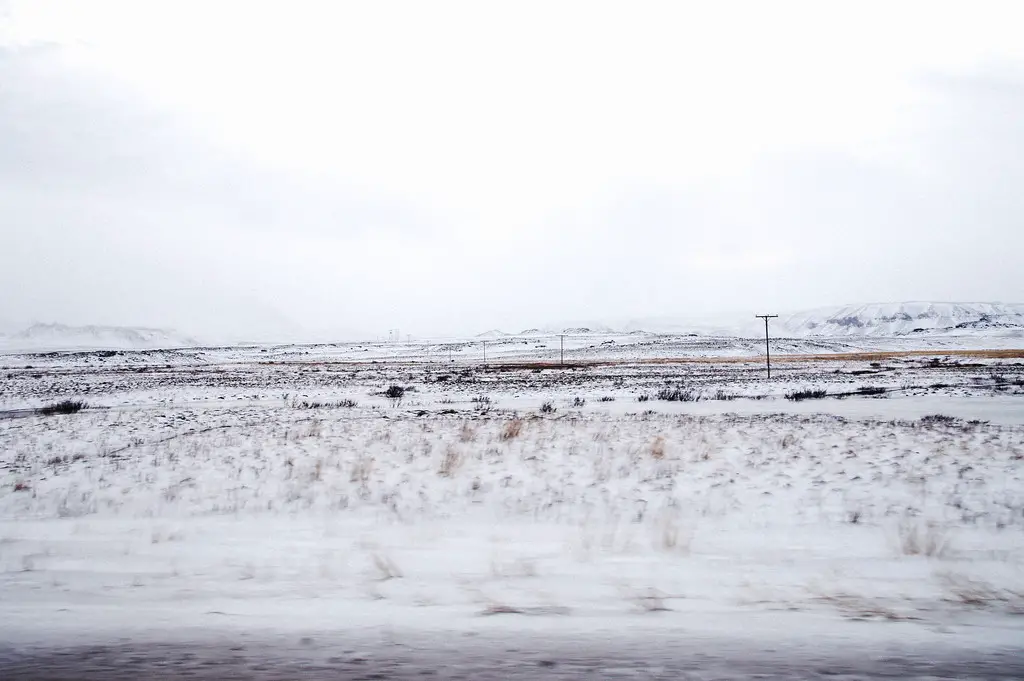
HOW TO GET TO ICELAND FROM LONDON
Getting to Iceland from London is fairly easy. You can jump on a flight from Luton, Stansted or Gatwick. Better yet, flights to Reykjavik are generally pretty affordable. Airlines that connect London to Reykjavik include EasyJet, Wow Air and Wizz Air.
All flights to Iceland land in Keflavik International Airport (REK), which is located approximately 45 minutes by car to the South of Reykjavik.
HOW TO TRAVEL AROUND ICELAND
I would generally recommend that you hire a rental car to explore Iceland at your own pace. That being said, it isn’t impossible to visit the country without one. If you are staying in a Reykjavik, your hotel will probably have a shuttle bus to ferry you from the airport to the capital. Most hotels also offer tours and daytrips to Iceland’s many attractions.
There are several car rental companies near Reykjavik airport. This is also the perfect place to start your road trip around Iceland, so it makes sense to rent your hire car from day one.
Whether you hire a four-wheel drive or a sedan/hatchback, depends on your personal preference, the season and your travel plans. I spent a lot of time before our trip trying to figure out whether we really needed a 4WD. I read several blog posts and reviews. Opinions were split. Some people believe that a four-wheel drive is a must have in Iceland, others clearly think that it is a waste of money.
Since we were travelling to Iceland in winter, caution won the argument and we ended up hiring a 4WD. Let me tell you, we were so glad that we spent the extra bit of money. We experienced a couple of hairy moments on the snow-covered roads, couldn’t have made it to certain attractions without the 4WD and were generally glad for the extra piece of mind. And let’s be honest, it’s fun to drive a four-wheel drive.
Iceland’s famous ring road (also known the M1) runs along the outer edge of the country and encircles the entire island. This national road connects the majority of Iceland’s towns and covers over 800 miles. Most tourists follow the ring road due to it’s close proximity to most of Iceland’s most popular attractions. In theory, you could probably drive around the entire island in under 24 hours. In reality, it will take you over a week, especially if you take into account all the stops you will be making along the way.
Here are a few more tips on planning a road-trip.
OUR WINTER ROAD TRIP ITINERARY FOR THE SOUTH OF ICELAND
DAY 1 –A WATERFALL AND A LUXURIOUS HOTEL
RENTING A 4X4 IN ICELAND – A NICE SURPRISE A THE RENTAL COMPANY
We landed in Iceland rather late in the day and headed straight to our car rental company (rent 4×4) to pick up our vehicle. We had booked a GX Suzuki S-Cross. After choosing our insurance package, we were informed that the GX Suzuki S-Cross and that we had therefore been upgraded to a Jeep Renegade. Although a little surprised, we couldn’t have been happier.
The car came with a full tank, so there was no need to stop at a gas station. Yet! We typed the address of our hotel in the complimentary satnav and off we went.
Iceland was covered in snow and the white powder covered the island’s landscape as far as our eye could see. We did get lost a couple times. Mainly when we drove down towards one of Iceland’s F-roads, only to find out that they are shut in winter.
But we did make it to our first waterfall in the end.
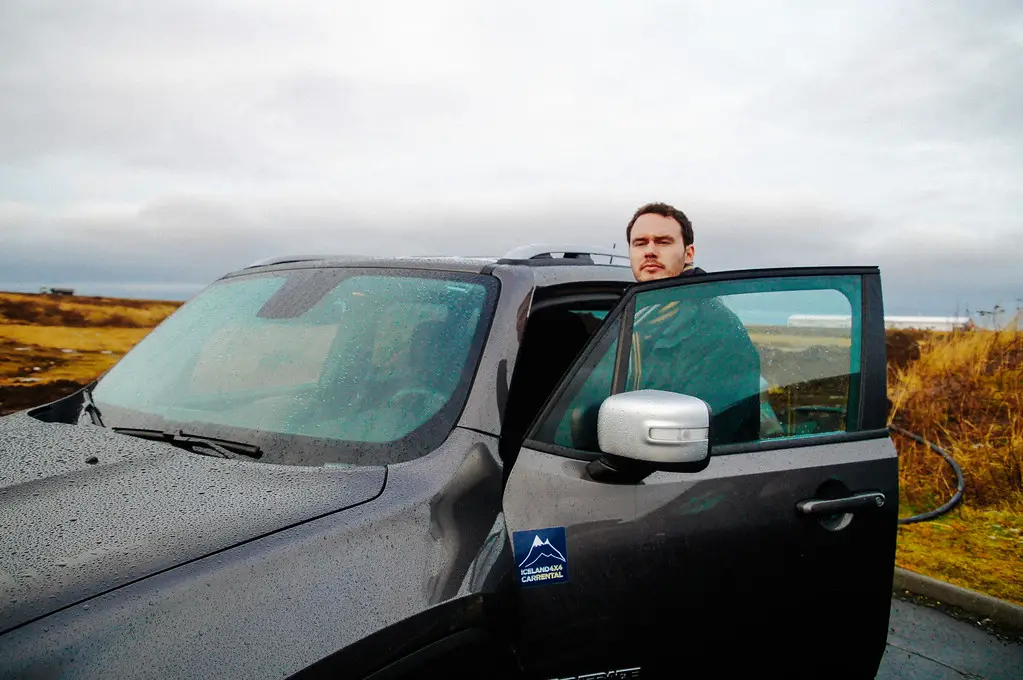
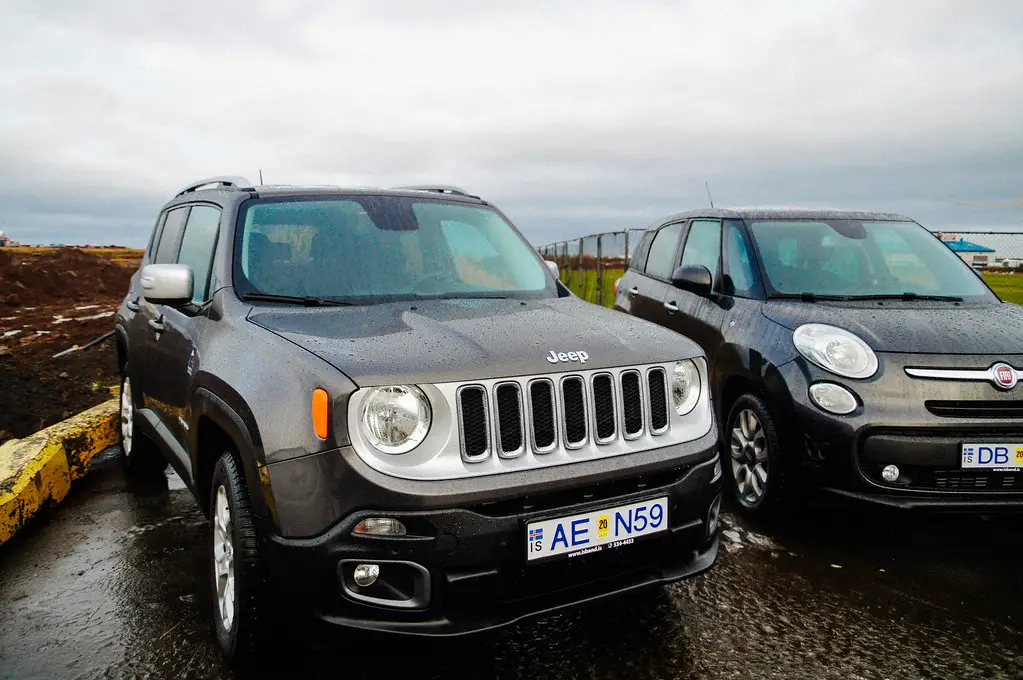

A SLIPPERY SLOPE AT A FROZEN SELJALANDFOSS
It took us two and half hours to reach our first Icelandic destinations. Seljalandsfoss drops over 65 meters (213 feet) and is one of Iceland’s most famous waterfalls. Surrounded by green fields and black cliffs, it is definitely a very picturesque sight to behold.
What makes this waterfall rather unique however is that you can walk behind its watery curtain. As long as you don’t mind getting a little wet that is.
A short path leads from the carpark towards the waterfall, then curves up and round allowing visitors to take a peek behind the falls
Unfortunately, on the day we visited, the ground around Seljalandsfoss was frozen, making it impossible to reach the secret cave. Of course, we attempted to get as close as possible and had a lot of fun on the slippery slope on the way. To be fair I nearly didn’t make it back to the car in one piece.
Sunsets at Seljalandsfoss are beautiful. The sunlight reflects in the tumultuous water, turning it into liquid gold. It’s also possible to camp within view of the waterfall, and given its remoteness and lack of light pollution, it’s probably a great spot to wait for the Northern Lights




DINNER AT HOTEL RANGA
We jumped back into our Jeep and drove 20 minutes North-West to Hotel Ranga, where we were staying for two nights. It was our first night in Iceland and we decided to relax in our room for the rest of the evening. Now, normally I suffer from severe FOMO and therefore attempt to squeeze as much out of our trips as humanly possible. However, the sun had set about an hour ago, so we decided to take a more relaxed approach towards this trip.
We opted to have dinner at our hotel. Iceland isn’t particularly famous for its variety of food. If you don’t like fish and lamb, you might struggle to satisfy your palette. Thankfully I have always been adventurous, especially when it comes to food. Unlike Gary. So, on our first night in Iceland, I tried some reindeer before moving on to arctic char. Gary chose to stick to a bacon burger for his main. Although he did order puffin for his starter.




DAY 2 – THE SOUTHERN COAST OF ICELAND
The next morning, as we pulled the curtains back, it was obvious that the weather was not on our side that day. Whilst the snow had melted, it was raining outside. Hard.
We enjoyed a pretty luxurious breakfast at Hotel Ranga, packed our camera gear and then hit the road. The plan of attack for the day was to make it as far East as possible before the sunset and with plenty of breaks on the way.
Despite the low levels of light and the heavy rain, the journey East wasn’t that bad. In fact, we only passed maybe three other cars in the 560km we travelled that day.
WE GOT SOAKED AT SKOGAFOSS
Our first stop of the day was Skógafoss, which personally I found even more impressive than Seljalandsfoss. In fact, it is probably my favourite from all the waterfalls we saw in Iceland.
Skogafoss is actually one of the biggest waterfalls in Iceland, with a width of 25 metres (82 feet) and a drop of 60 m (200 ft). A set of stairs lead to the top of the waterfall. From here you often see rainbows because of the mist created by the spray of water.
I would imagine that the trek is usually worth the effort, however, due to the weather conditions the steps were extremely slippery and I personally didn’t fancy falling over and injuring myself.
We attempted to get as close as possible to the wall of gushing water and got soaked in the process. The wind was blowing just at the right angle to drench us from head to toe. It almost felt like we were taking a shower and I am not entirely sure how my camera survived it.
On our way back to the car we spotted a little hot chocolate van, which was exactly what we needed at that point, to warm ourselves up. Back in our Jeep, we removed all items of clothing, bar our thermal underwear, and cranked the temperature up to its maximum. I have never been more grateful for heated seats.



BLACK SAND AND ROCKY OUTCROPS AT DYRHOLAEY
Our next destination was Dyrhólaey, about 30km further East. I read that this was the perfect spot to enjoy fabulous views across the Southern Coast, it’s rocky outcrops, tidal pools and black sand beaches. You can either drive directly to the beach or turn right and drive up to the lighthouse. If you have time, do both. However, if like us, you are short on daylight hours, I suggest you do the latter.
Although the road to the Lighthouse is supposed to be accessible by a 2WD, we were struggling to get up there in a 4WD. Now, this could be because of the poor weather conditions. Nonetheless, I was glad that we had invested a little extra money into our vehicle, especially when we spotted another car get stuck in the grit and then turn back on itself.
The rocky outcrop of Dyrhólaey has two different viewing points. One overlooks the black sand beach below. The other one is located a little further up and is the perfect place to photograph Dyrhólaey’s iconic arched rock jutting out of the ocean. The arch was naturally created by erosion and the outcrop was named after it’s unusual shape. Indeed, Dyrholaey literally translates as “door hole”.
On sunny days you might be able to spot various seabirds on the rocks, including puffins. Unfortunately, this wasn’t the case when we visited. Instead, we got knocked about by the wind, which was rather intense near the lighthouse.
If you have enough time, drive down into town and leave your vehicle in the main car park. The award-winning black sand beach should not be difficult to find from here. Just follow the signs and people heading in the same direction. Reynisfjara Beach is one of the wettest places in Iceland and home to several basalt columns and caves, which are continuously carved and shaped by the sea. It’s quite an otherworldly experience.




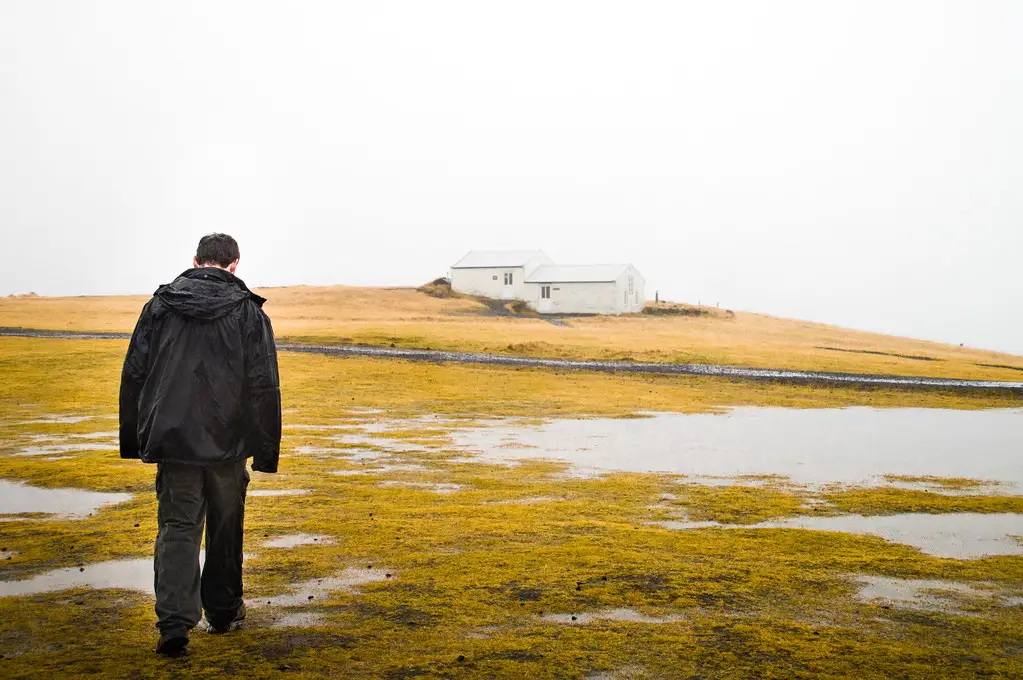
A PIT STOP IN VIK
From Dyrhólae we continued on to Vik, the most southern point of our entire road trip. I found out later that the full name of the town is actually Vík í Mýrdal, but I didn’t see that mentioned at all while we were in Iceland.
Sitting right along the Ring Road, Vik is the largest town in the area with a bustling population of about 300 people. There is nothing even near its size for 40 miles in all directions. Yeah, Iceland is pretty void of humans!
If you don’t have a camper van, then Vik is a good stopping point for lunch. There is a restaurant, Sudur Vik, which isn’t cheap. But then nothing really is in Iceland. For a more affordable lunch you can pop into the local supermarket. Or you could grab a sandwich and crisps in the service station, like we did.
Make sure to walk or drive up to the beautiful whitewashed church located at the top of the hill. The view across Vik and down to the black sand beach below is unbeatable. The Church is actually an evacuation point should the nearby Katla volcano erupt or the town be at risk of flooding. There is plenty of parking available beside the church and I would, therefore, recommend you start your exploration of Vik from here.
As it happens it was pouring down with rain when we visited. So, we stayed in our warm car and simultaneously enjoyed the panorama and our sandwiches.


SANDUR – THE DESERT OF ICELAND
Once our lunch was finished, we continued our road trip to the South East of Iceland. We had two more locations to get to and the sun was already starting to set.
We immediately noticed that the grassy fields on either side of the Ring Road had turned into moss-covered rocks as far as the eye could see. These rocky fields were formed by molten lava from Iceland’s incessant volcano activity. If you decide to go for a walk across the rocks, please be mindful of where you step. The ecosystem of these lava fields is pretty fragile.
Soon, even the moss disappeared, and we found ourselves in the middle of a sandur. These plains are formed by sediment deposited by melting glaciers. Nothing seems to grow here making the landscape pretty desolate. The wind also tends to whip across these plains at high speeds and if you’re not careful you can get caught in a sandstorm.
Making our way through this rocky desert, Gary and I felt entirely isolated from the rest of the world. Iceland isn’t that small of a country. In fact, it is almost three times the size of the Netherlands and half the size of the UK. But it only has a population of 329.000 and a third of them live in Reykjavik. So it is no surprise we didn’t pass many other cars.

VIKING COTTAGES OF NUPSSTADUR
Although we still had another 50km ahead of us before we would reach our final destination, Gary and I made the executive decision to make a brief stop in Núpsstaður. This 19th-century farm is located near Fljótshverfi in the easternmost corner of Katla Geopark.
Núpsstaður is easy to miss, but well worth looking out for. It features one of Iceland’s last turf chapels and is generally very photogenic. The road leading up to the farm was marked as private, so we left our Jeep on the side of the Ring Road and then made our way up the hill by foot.
Núpsstaður has had a turf church since the 13th century. The current chapel, however, was built in 1650 from the remnants of an older church. It gradually fell into disrepair and was deconsecrated in 1765 by a letter from the King. It might have been used as farm church or an oratory for a while before being turned into a storehouse. The chapel then became Iceland’s first protected building in 1930 and was put under the care of Þjóðminjasafn Íslands – the National Museum of Iceland. Finally, in 1961 the small chapel was re-consecrated
The altar in the chapel originally belonged to the Stóra-Dalskirkja church and dates back to 1789. The chandelier belonged to Víðimýrarkirkja turf church in North-Iceland.
Núpsstaður farm also features several turf houses (19 to be exact) some of which are more dilapidated than others. All of them, however, are good representatives of Iceland’s 17th-century architecture.
The backdrop to Núpsstaður farm is formed by the majestic mountains of the Vatnajökull National Park, the most famous one of which is Mt. Lómagnúpur. The ring road as it is known today didn’t exist until 1974. Up until then, the road from Reykjavik led to the base of Mt. Lómagnúpur, which stood like a massive guardian in front of the unbridged black sand plains of the south. Hannes Jónsson, who lived in Núpsstaður from 1880 to 1968, used to help travellers cross the rivers of Skeiðarársandur. His grave can be found in the graveyard behind the church.



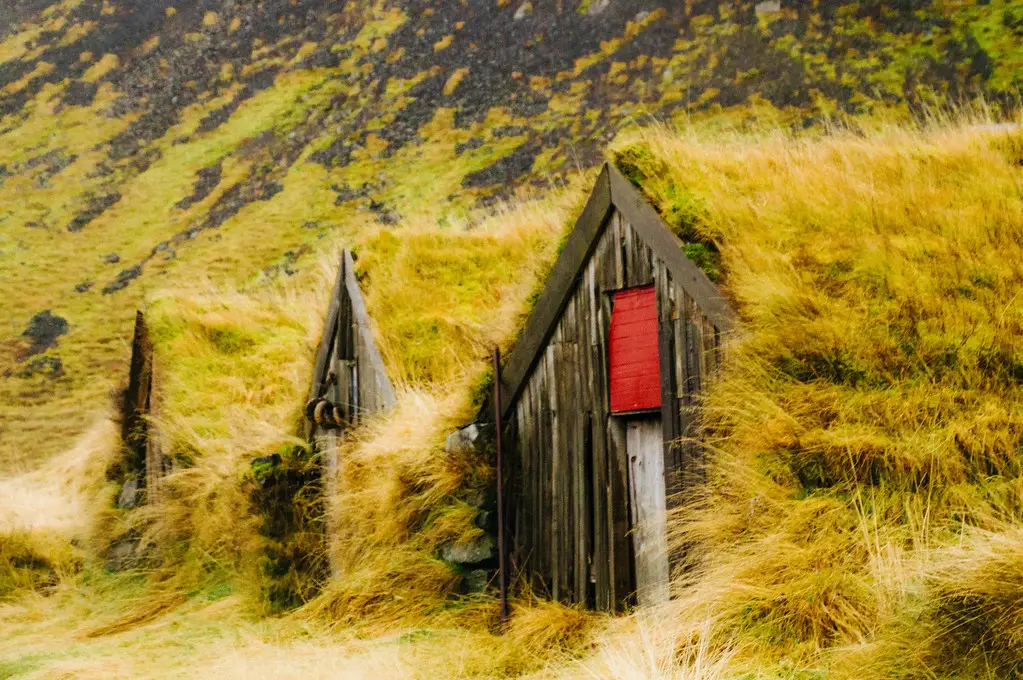

SINGING ICEBERGS OF JOKULSARLON
I had an inkling that Jökulsárlón would be one of the highlights of our trip to Iceland and was therefore rather desperate to make it to the glaciers before the sunset. We eventually got there in the nick of time, 30 minutes before total darkness. Being an utter perfectionist and having to shoot in such low-light isn’t ideal, but there was no way I wasn’t going to share pictures of this absolutely stunning location with you.
The Jökulsárlón Glacier Lagoon is a large iceberg lagoon running off the Breidamerkurjokull glacier, which itself is part of the largest ice cap in Europe, Vatnajokull. In fact, Vatnajokull glacier is so large that it covers 8% of Iceland!
Massive chunks of ice fall into the lagoon and then drift several miles out into the sea. Some of the ones we saw were as tall as a car or even a house. Most of these icebergs will float in the lagoon for about 5 years, before disappearing forever in the Atlantic Ocean.
Due to the weather conditions, our visibility wasn’t great. Nonetheless, the vibrant blue glaciers floating in the crystal-clear lagoon were an amazing sight to behold, making Jökulsárlón one of the most beautiful places we had ever been to. In fact, it all felt somewhat surreal.
In the summer months (when the days are a little longer) you might notice a flurry of activity on the shores of Jökulsárlón lagoon. Most tourist will hop on a Zodiac boat to get up close and personal with the icebergs. As you can imagine, these tours fill up quickly so if you do want to get on one then book early.
If like us however you decide to visit Iceland in winter, you will mainly experience the lagoon from the sidelines. Due to the frozen water, the zodiac boats don’t run during the winter months. But that doesn’t necessarily need to be a bad thing, in fact, it is somewhat of a blessing in disguise. Instead of rushing to get onto a boat, you can explore the lagoon at your own pace and take photos from a variety of different locations and perspectives. The other clear advantage is that you don’t need to deal with busloads of people getting into your field of view.
We slowly made our way around the lagoon, taking photos and gawping at the incredible panorama that unfolded in front of us. Sometimes we would stand still and watch one iceberg crash into another. Occasional there was a loud crack that echoed around the lagoon, as a large iceberg surrendered icebergs surrendered to its own weight and toppled into the icy waters. We even saw a lonely seal playing in the icy water of the lagoon. If you look close enough at my picture you might be able to spot the little black dot between the icebergs.
After an hour spent walking around the lagoon, our hands and toes were frozen, and we got back into our rental car. It was time to head back towards our hotel and we still had a three-hour drive ahead of us.
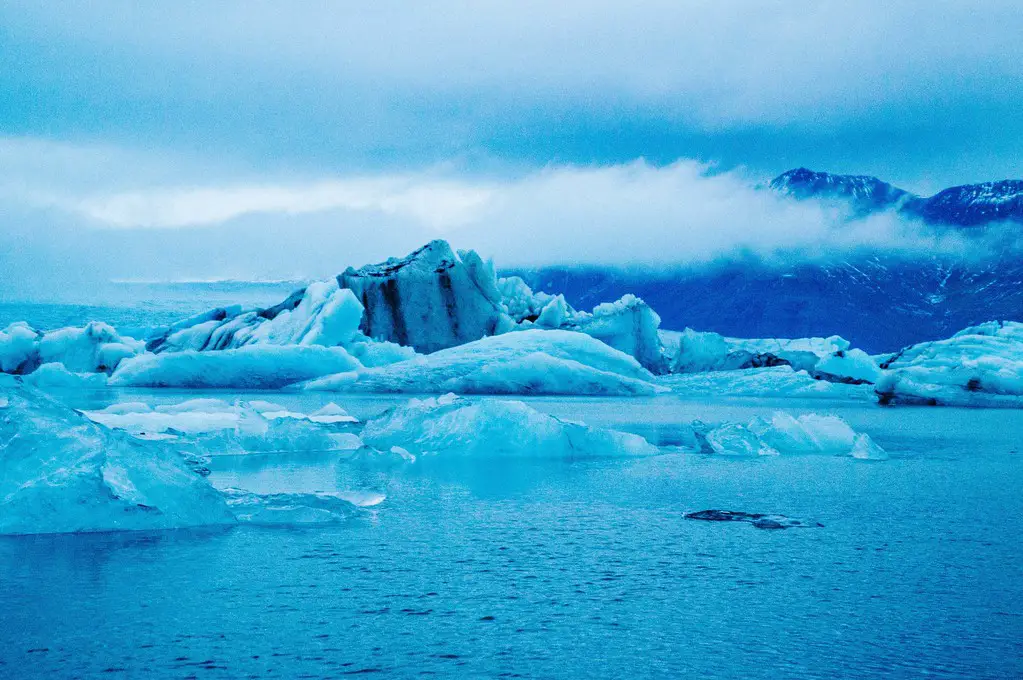
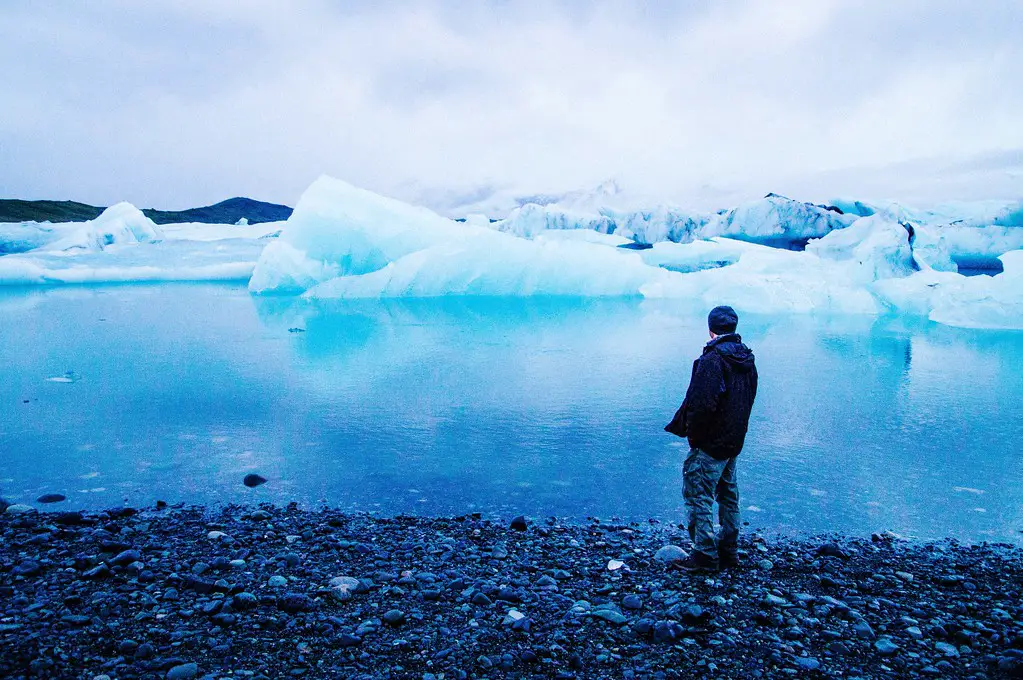
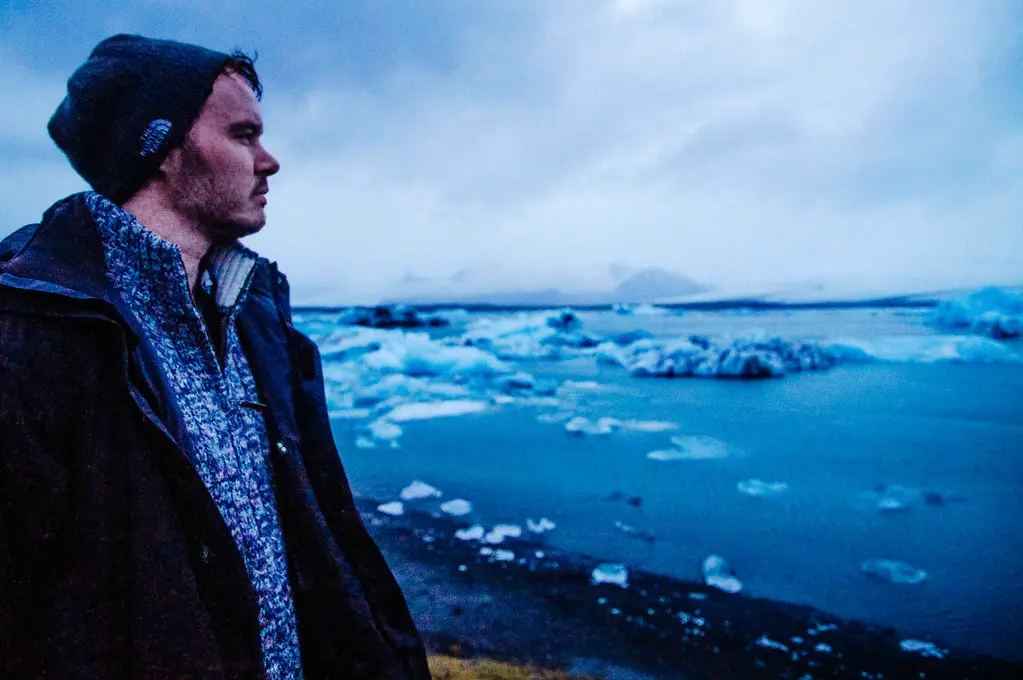
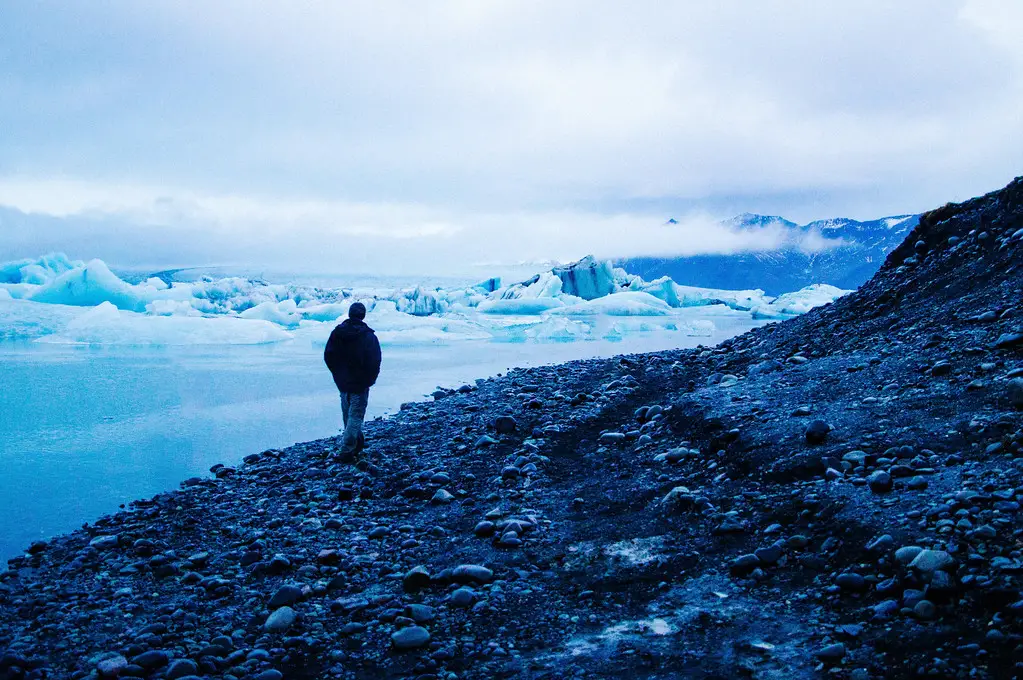
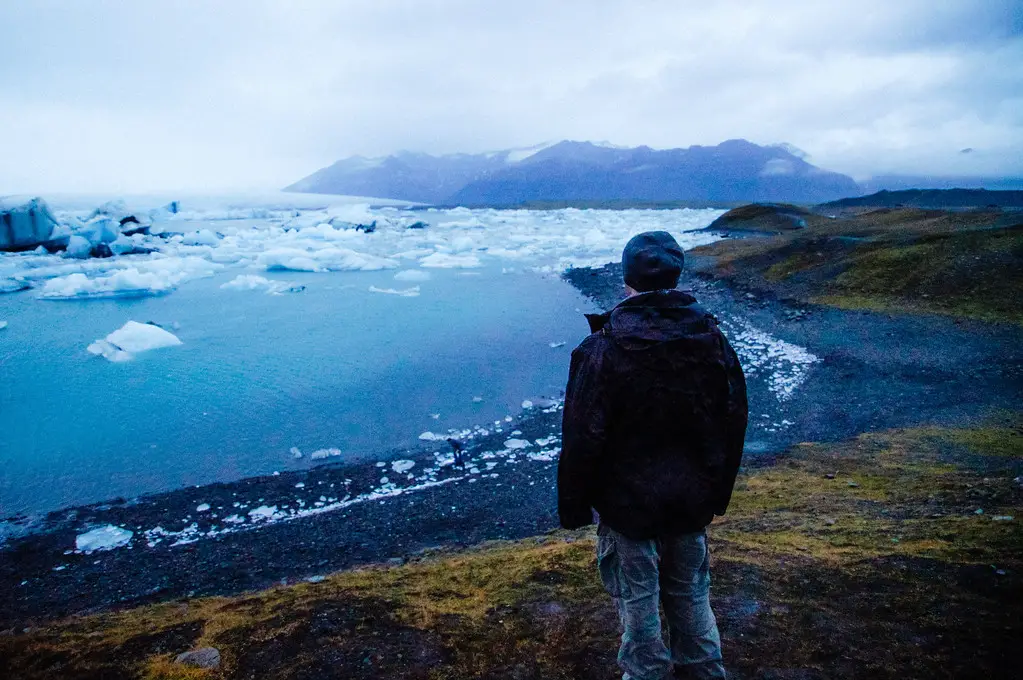
DAY 3 – THE GOLDEN CIRCLE
This was our last night at Hotel Ranga. So, after breakfast, we packed our bags, said goodbye to our cosy room, and got back on the road to head towards Reykjavik. Not without taking a bit of a detour first, however.
After a very exciting road trip on our second day, we were keen to explore more of Iceland’s fantastic landscapes. The Golden Circle is arguably Iceland’s most popular attraction, and there are plenty of tours of the area. Sure, you could hop on to a tour bus, but if you are more than one person, hiring a car might actually save you some money. Plus, it is far more convenient to visit these incredible sights at your own pace.
Note, that since we were driving towards Reykjavik from Vik, we did the Golden Circle in reverse order.
STEAM AND HOT WATER AT THE GEYSIR
We started our day at Geysir, a natural geothermal area beside the Hvítá River. The smell of sulphur hit my nose as soon as we left tour Jeep in the nearby carpark. Slowly we picked our way through the boiling pools and sulfur-scented steam clouds to the main attraction – the Great Geysir.
Did you know that all other geysers in the world were named after this one in Iceland? The Great Geysir has been active for over 10,000 years and was one of the very first known to modern Europeans. Unfortunately, some less-than-bright tourist decided it would be a good idea to throw rocks into the original Geysir caldron and as a consequence, it doesn’t erupt that regularly anymore.
Strokkur (its neighbouring geyser) however erupts every 5-10 minutes and, when it does, ejects a 15-20m tall column of hot steaming water (80-100 °C) into the air. Sometimes it’s eruption even reaches a height of 40 meters! It’s all rather impressive. We found a spot in between the crowd of people that had gathered around the giant hole and watched the spectacle for a good 20 minutes. Below are some of the many pictures I captured during Strokkur’s eruption. Don’t get too close though, our neighbour got soaked in geyser water. Fortunately, it wasn’t too hot by the time it came back down.
The geysers are initially set off by earthquakes, so this natural area is in constant. This geothermal area is also a great rest stop on a road-trip, as there is a gift shop and restaurant where you can warm up and grab a snack
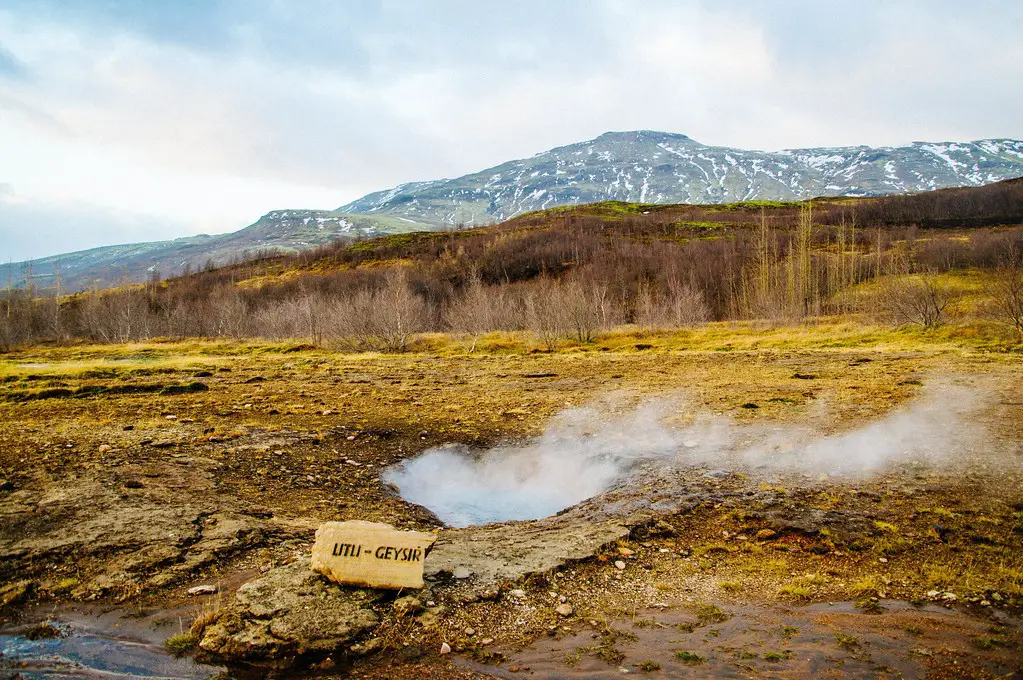
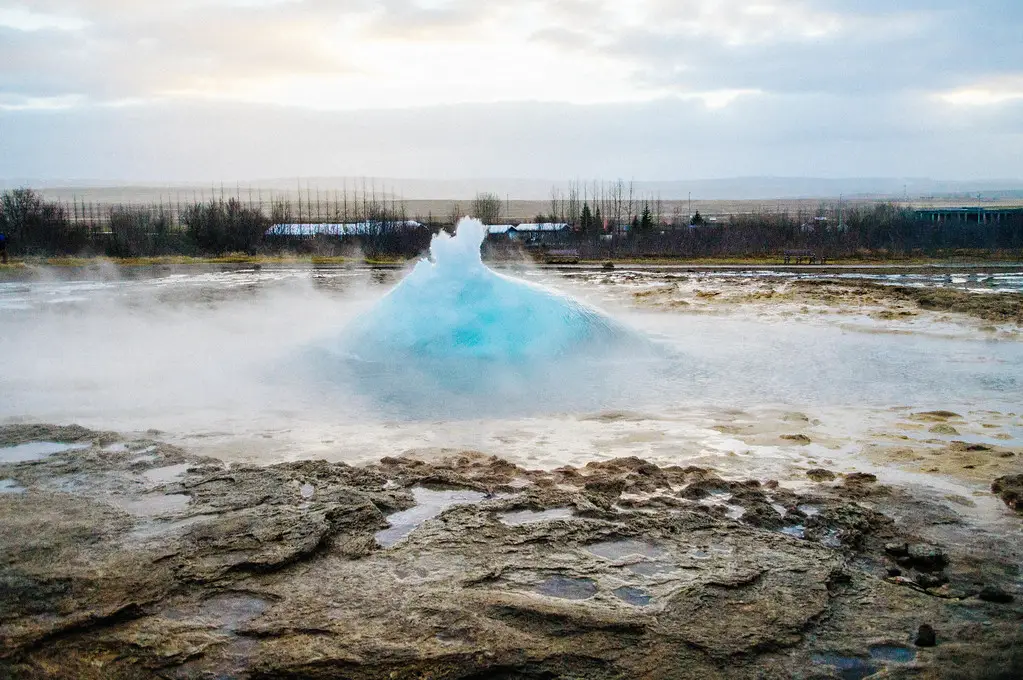
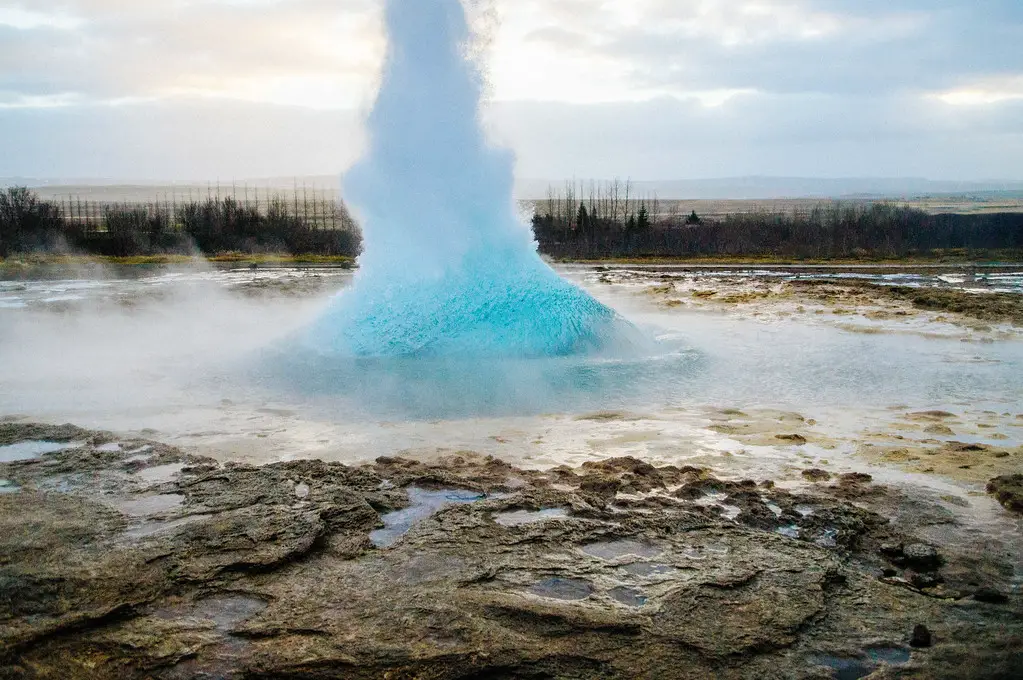
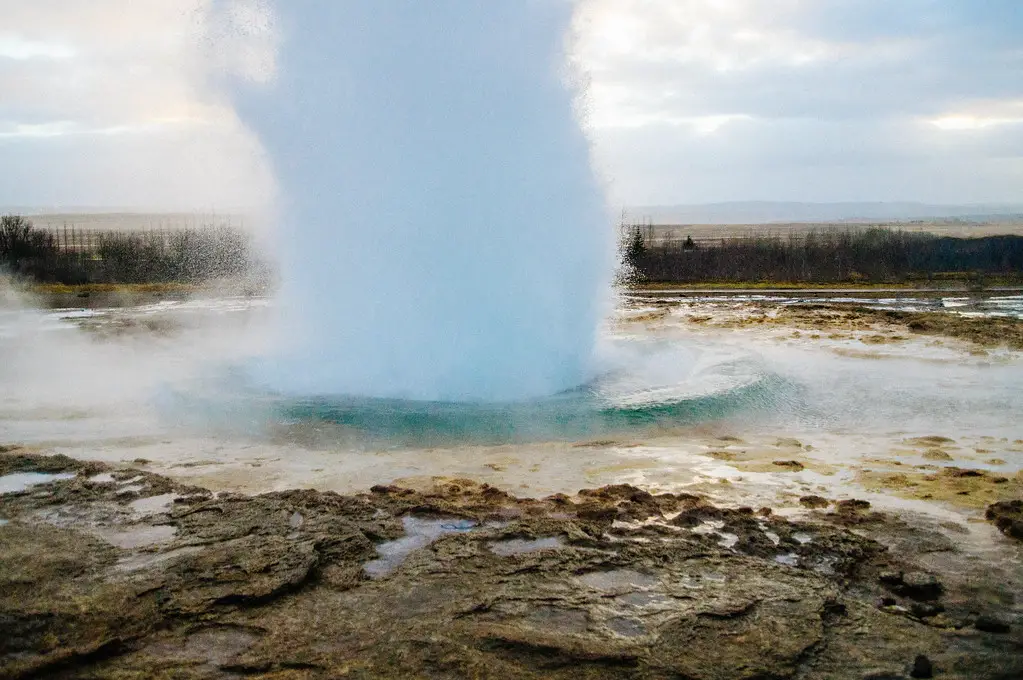
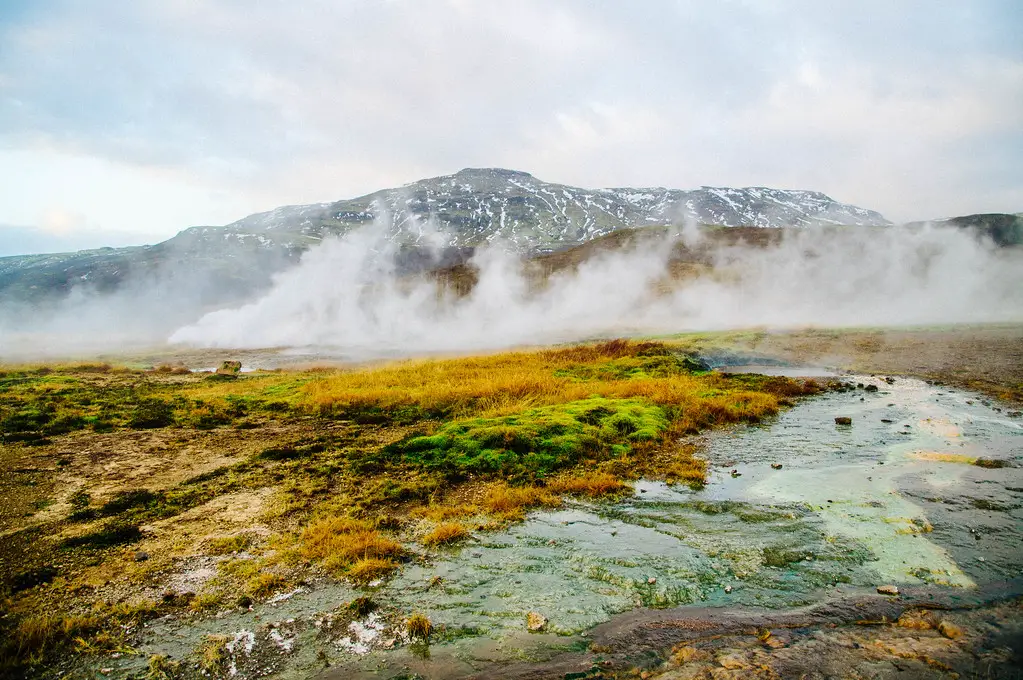
ICELAND’S MOST IMPRESSIVE WATERFALL– GULFOSS
It only took roughly ten minutes by car from the geothermal park to the next stop on our Golden Circle tour. Gullfoss Waterfall is one of Iceland’s top tourist attractions. Both because of it’s natural beauty and it’s relative proximity to Reykjavik.
Gulfoss is probably the biggest waterfall we saw on our road trip around Iceland. It falls in two tiers and then drops down into a deep ravine and away from view. The waterfall is located on the Hvítá (White) river which is fed by Iceland´s second biggest glacier, the Langjökull. More water passes through Gullfoss annually than does through the Niagara Falls. Can you believe it?
In fact, Gulfoss Waterfall almost got turned into an electric generator in 1907. The farmer Tómas Tómasson first declined the offer from the English businessman but ended up leasing the waterfall to him a little later. The farmer’s daughter, Sigriður Tómasdóttir, did everything she could to void the rental contract. She spent years in trial and had to journey all the way to Reykjavik by foot. Although her attempts failed, the construction of the power plant never began, and the rental contract was eventually cancelled in 1929. Sigriður is considered to be Iceland’s first environmentalist because of her efforts to rescue the waterfall. Gullfoss and its surroundings were eventually turned into a nature reserve in 1979.
You can get a view of the waterfall from above or head down to walk along the edge looking into the abyss of rushing water. If you take the latter route, be sure to come prepared with a raincoat (and perhaps waterproof pants) as you will get rather wet in the mist.
By the time we arrived at Gullfoss Waterfall, the sky had become pretty overcast. Fortunately, there were a couple of breaks in the clouds and the mix of rain and sun even created a gorgeous rainbow. Due to the freezing temperatures, however, the paths down to the falls were extremely icy and slippery. So, we couldn’t get very close to the waterfall itself. We nonetheless enjoyed the view of the falls from the paths we could walk on.
As enchanting as the waterfall might be, I wouldn’t spend more than 90 minutes here. There are still plenty of other things to see on the Golden Circle tour and in winter the sun sets fast.





STRADDLING TECTONIC PLATES AT PINGVELLIR NATIONAL PARK
As sunset was fast approaching and we still had one more destination on the day’s itinerary, we reluctantly dragged ourselves away from Gullfoss Waterfall, jumped into the Jeep and drove to Þingvellir (Thingvellir) National Park.
This UNESCO World Heritage Site is both an amazing geological formation and an important part of Icelandic history. Thingvellir National Park straddles both the North American and Eurasian tectonic plates. Both tectonic plates are slowly drifting apart, by approximately two centimetres every year, and this creates a deep rift between them.
In 930, Þingvellir National Park hosted the first Alþingi (Althing), an open-air parliamentary assembly . From then on, the Icelandic assembly met here for two weeks every summer, in an event that was part festival, part governance meeting, part trial, and part flea market. It would create covenants and settled disputes. This continued up until 1798. Fragments of around 50 turf and stone booths used by the Althing assembly can still be seen in the National Park today. Further remains of the 10th century are thought to be buried underground and the site also features traces of agricultural use from the 18th and 19th centuries.
Your first stop should probably be the Thingvellir Visitor’s Center. But don’t forget to grab a parking ticket from the Visitor Centre or the Information Centre. It costs roughly £3 for the full day and you can move your car between the various car parks of the national park at any point.
From here walk to the observation deck and enjoy the view out over Þingvallavatn, the biggest glacier lake in Iceland. You might even get a glimpse at the people preparing to scuba dive between the two continental plates. It is truly a unique experience as Iceland is the only place in the world where this rift occurs above sea level. Then head down through the Almannagja Rift, a canyon between the North American and Eurasian tectonic plates. You can walk in the canyon for about 2 km before you eventually reach Öxarárfoss waterfall.


OUR HOTEL IN REYKJAVIK
We ended the day in Reykjavik, where we checked into our hotel for the next two nights . Our room was rather small but had everything it needed. I really appreciated the modern design of this Icelandic hotel. The best thing though was the private car park in the basement.
We then spent an hour exploring Reykjavik in the dark. We couldn’t believe how busy the city was in comparison to the rest of the country. A lot of the restaurants on the main high street were packed to the brim. We did eventually find a little restaurant to turn into though. I ordered Alaskan Char for the second time, while Gary stuck to an old-fashioned steak. Crepe Suzette rounded the night of nicely.
DAY 4 – EXPLORING REYKJAVIK
It’s pretty inevitable that you will spend at least one day exploring Reykjavik during your holiday in Iceland. The name of the capital is in fact comprised of two words (Reykja = smoky and Vik = bay) and thus Reykjavik translates to Smoky Bay. This is because the settlement was originally built near steaming hot springs.
Reykjavik is not only the capital of Iceland, it is also the most northern capital city in the world. This urban centre is home to 130,000 people, so just over one-third of the population of Iceland. And this is what makes Reykjavik feel both small and gigantic at the same time.
Although Reykjavik is the most densely populates area in the entire country, it is very easy to explore by foot. The architecture of Reykjavik isn’t that of a big capital city either. Although Reykjavik’s colourful houses and shops have plenty of charm, you’d expect to find them in a small town not the main urban centre of the country.
The backdrop of snow-covered mountains, paired with the perpetual sunrise and sunset in winter means photos are bound to be beautiful, it’s always golden hour at this time of year. Finally, there are several fantastic museums and numerous excellent restaurants to be found in Reykjavik.
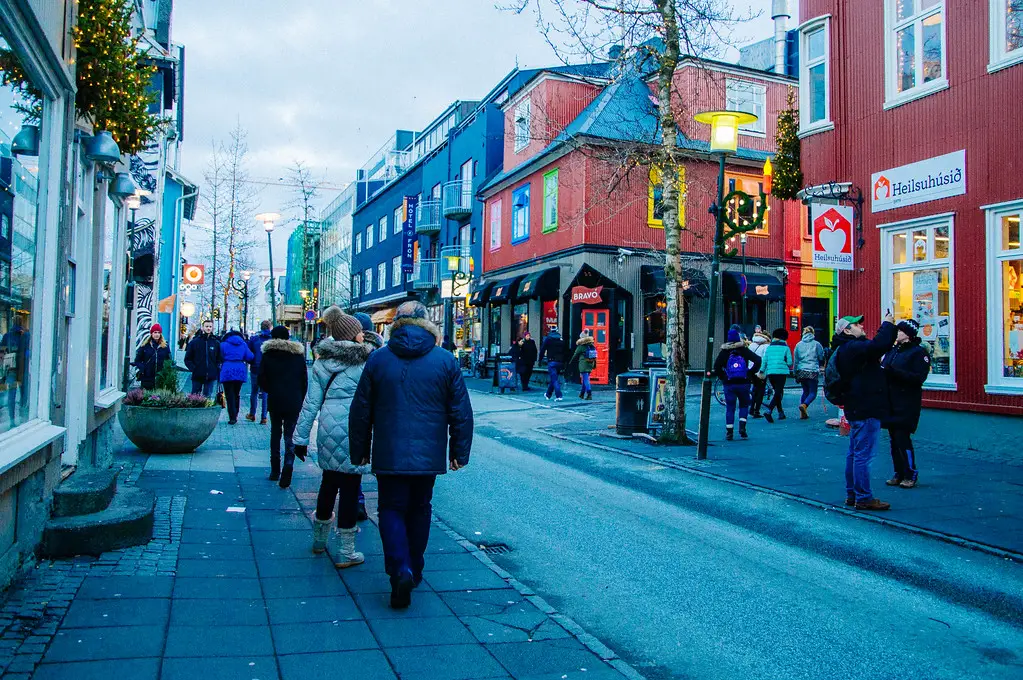
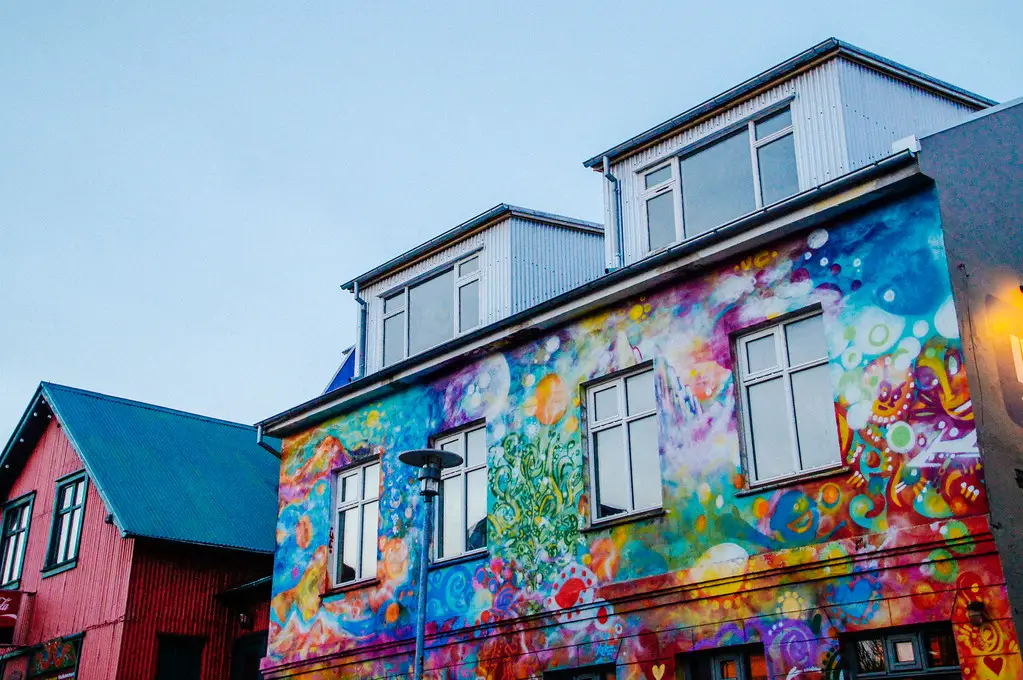
A WALK AROUND TJORNIN LAKE AND THE CITY CENTRE
Our first stop of the day was Tjornin Lake. It only took us 5 minutes by foot from our hotel to reach its shore. There are few places quite as scenic or better suited for a morning stroll in Reykjavik than this icon of the inner city.
Though categorically a lake, the water body is referred to colloquially as a pond due to its extremely shallow depth. However, referring to Tjörnin as a singular pond is rather deceptive too. Tjornin Pond is actually comprised of five different water bodies, stretching away from downtown toward Reykjavík’s Domestic Airport. As for its name? Tjörnin is derived from the Old Norse ‘tjörn’, an ancestor of the Northern English ‘tarn’, meaning “mountain lake
You will find a lot of wildlife in Tjornin Pond as it is part of the Vatnsmyrin reserve, a protected moorland in Reykjavik and nesting ground to many species of water birds. The pond itself is home to 40-50 different species of water birds, including ducks to geese, swans and Arctic teens.
The lake is not only popular with wildlife, however. It is also beloved by the inhabitants of Reykjavik, who flock to its shores for many different leisure activities. It is well-regarded amongst the city’s inhabitants as an excellent place to stroll, walk the dogs and get in touch with Reykjavík’s surrounding nature. Kids particularly enjoy feeding the many birds. So much so that the lake is often referred to as “The Biggest Bread Soup in the World”. In winter the body of water freezes over and is turned into a gigantic ice skating ring.
The lakeshore is surrounded by a stone walkway and Reykjavik’s colourful houses on the western shore. Buildings of note located on Tjornin Pond include the Idno Theatre and Reykjavik City Hall. A little further down the shore, you’ll come across an impressive metal sculpture. The Solfar Sun Voyager is the brainchild and masterpiece of Jon Gunna Arnason. It somewhat resembles a Viking ship, however, was originally conceived as a dreamboat and ode to the sun.


ARCHAEOLOGY AT THE SETTLEMENT MUSEUM
Next, we walked across town to the Settlement Museum 871 +/- 2. We were keen to find out more about Reykjavik settlement, which is highlighted by the museum as having occurred between 868 and 872.
Ingolfur Arnarson was responsible for the first permanent settlement in Iceland in the year 874 and is thus generally considered to be the first Icelander. He used a traditional Norse method to determine the location of Reykjavik. A Ondvegissulur, made up of two wooden logs, was thrown into the ocean and where it washed up ashore was chosen as the site of the new settlement.
Strangely enough, the settlement museum is located in the basement of an ultramodern hotel, but it is definitely worth a visit. This museum, also known by its Icelandic name, Landnámssýningin, will really take you back into the Viking Age.
Its exhibits are very detailed, interactive and to Gary’s great excitement feature the foundations of the earliest hall in Reykjavik. Its remains were discovered in 2001, during the excavation of Aðalstræti street in downtown Reykjavík. The site was preserved and the remains of the hall meticulously reconstructed.
The exhibition also includes various archaeological artefacts that provide a wonderful glimpse into Viking life. Touch screens give access to some fascinating facts about the Vikings and how they expanded their territories and their cultural influence. The changes within Icelandic nature over the centuries are also highlighted.


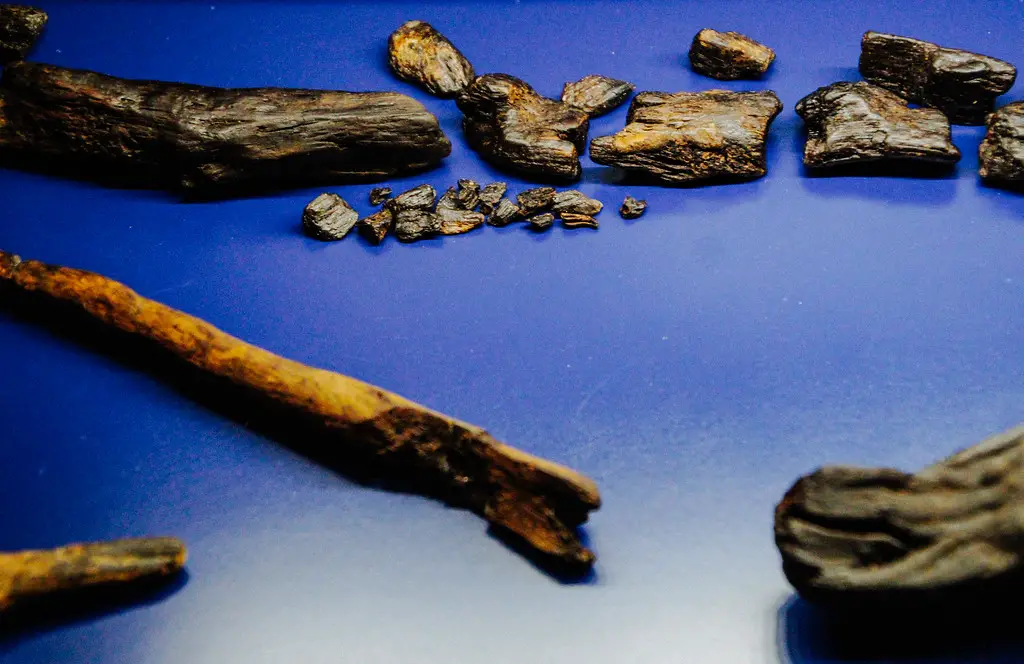

INTERESTING ARTIFACTS AT THE NATIONAL MUSEUM
In the afternoon, we decided to visit the National Museum of Iceland (Þjóðminjasafn Íslands), mainly because we hadn’t had our fill of Iceland’s history yet.
The National Museum is located in Reykjavik’s centre on the edge of the university campus and is pretty big (on an Icelandic scale, at least). It is also a lot more traditional than the settlement museum. Although Iceland’s human history extends just a little over 1,200 years, The National Museum of Iceland is jam-packed full of interesting artefacts.
Its exhibit features a collection of historical objects as well as iconic pieces from more recent periods, such as Bjork’s first album from 1977. This makes the National Museum a great place to get an overall impression of Iceland’s past.
The exhibit itself is well laid out and clearly explains the story of how the country came to be. It then proceeds to illustrate what Icelandic life was like in various centuries, from pagan burials to Iceland’s role in the Second World War. The exhibit touches everything related to this island nation from belief and religion, to seafaring, farming, culture, costume and the development of trade relationships from the beginning to the present day.
The main exhibition ‘Making of a Nation’ does include a couple of interactive elements, aimed at younger visitors. You can, for instance, have a one-way telephone conversation a medieval chieftain from 1117. Audio displays tell some fascinating stories and computers give access to a wealth of additional facts. Overall, however, we found the National Museum of Iceland to be less interactive than the Settlement Museum.
The ground floor of the museum houses a gift shop and cafe as well as an ever-changing photography exhibition. In fact, the National Museum’s Collection of Photographs and Prints is Iceland ‘s largest public collection of images. Over four million photographs are stored in the museum, from professionals as well as amateurs. So there is plenty of material for future displays!


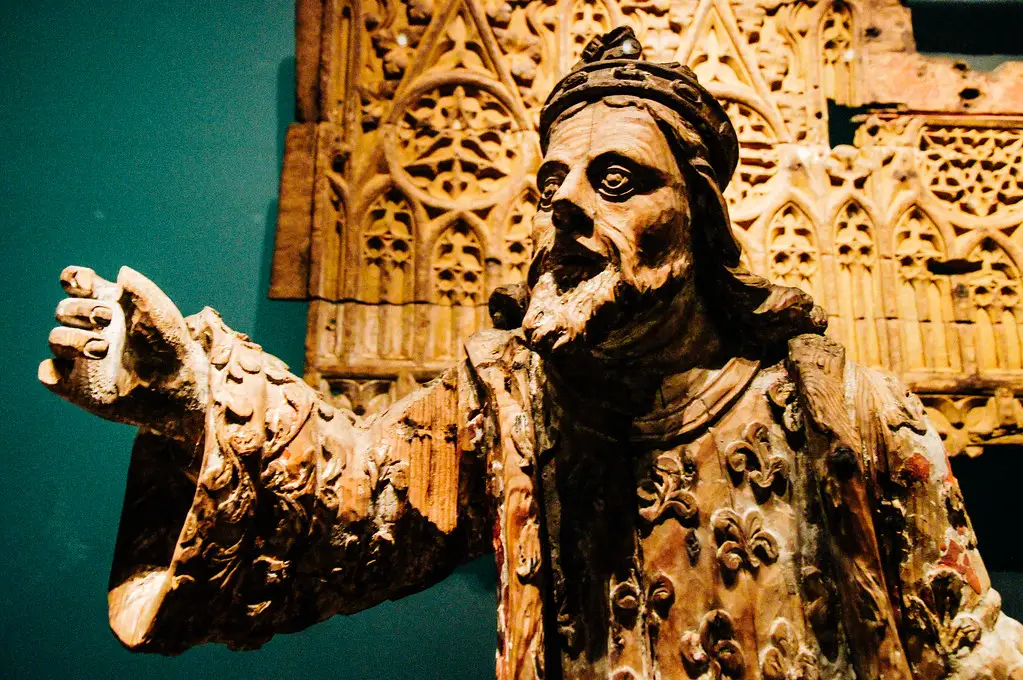

A CHURCH LIKE NO OTHER – HALLGRIMSKIRKJA
Finally, to round things off, we made our way to Hallgrimskirkja (Hallgríms Church), Iceland’s largest and most famous church. Along the way, we passed by a few houses with colourful graffiti and murals.
We spotted this iconic landmark from right across town, as it is located at the top of a hill and stands 73 meters tall. No wonder then that it dominates Reykjavik’s skyline.
Visiting the interior of the church is completely free. However, if you want to go up to the bell tower to enjoy some fantastic views of the city, you will need to shell out 900 ISK ($7.81 USD). You can take an elevator up, but you will still need to climb three flights of stairs to reach the viewing platform.
The interior of Hallgrimskirkja resembles an ice cave. In fact, the architect says he was inspired by the lava columns all around Iceland. Everything inside the church, except for the organ, is a shade of light grey.
Gary though was more fascinated by the statue of Leif Ericson out in front of the church. The statue was gifted to Iceland by the United States, to commemorate the 1000 year anniversary of the Alpingi. If you don’t know your Viking history, then the name Leifur Eiriksson might not mean a great deal to you. He was, however, the real discoverer of America and officially recognized as such by the United States in 1930. He was the first European man to travel to America and did so 500 years before Christopher Columbus.





DAY 5 – RELAXING AT THE BLUE LAGOON BEFORE OUR DEPARTURE
Our flight back to London was in the early afternoon, so like many a tourist, we decided to relax in the Blue Lagoon beforehand.
Due to its locations atop the junction of the North American and Eurasian tectonic plates, Iceland has a lot of geothermal activity. Naturally Icelandic people are therefore great promoters of the benefits of taking a dip in thermal water. Most hotels and several guesthouses have hot spring pools in their basement. Some people travel to the northeast of Iceland to relax in the Myvatn Nature Baths, surrounded by mountains.
The granddaddy of all geothermal baths, however, is the Blue Lagoon, located between downtown Reykjavik and the airport. It is one of the most iconic tourist destinations in the world. If you tell anyone that you flew to Iceland, they are bound to ask you if you visited the Blue Lagoon.
Before our trip to Iceland, I wasn’t convinced that the Blue Lagoon wasn’t just another a tourist trap, but we decided to give it a shot anyway. And I am glad we did, It was actually one of the highlights of our holiday.
The Blue Lagoon complex is gigantic and ha a car park to suit. Inside it is pristine and clean. After paying your entrance fee, you are given a wristband. This gives you access to your locker and can also be used to purchases drinks in the lagoon.
The thermal bath itself is wonderful. The temperatures of the water will help you relax and I am convinced have therapeutic benefits too. Make sure to try out the silica scrub. There are buckets of it around the pool and a station at the centre. Simply cake your face in it and let it work its miracle. Your skin will end up feeling super smooth. Do not, however, plan to eat at the Blue Lagoon. You would just end up paying through your nose. Better to grab a quick bite to eat, like we did, at a garage before driving back to the airport.
After an afternoon well spent at the Blue Lagoon, we hopped into our Jeep for the very last time, to head to the airport. Here we dropped off our rental car and then boarded our plane to London. We were very sad to leave but are planning to return to Iceland very soon.




FINAL THOUGHTS ON OUR WINTER ROAD-TRIP AROUND ICELAND


And that sums up my guide to spending 5 days road-tripping in Iceland! Hopefully, you’ve found this post useful.
I’m continuing to add more content about Iceland from our experiences travelling in this beautiful country, so check back often for more. In the meantime, I think you’ll find the following resources useful for planning your Iceland trip:
- For the first two nights, we stayed at Hotel Ranga, in the South of Iceland, near Vik. I have written a very detailed review of our experience at this extravagant boutique hotel.
- We decided to find out for ourselves why there is so much hype around the Blue Lagoon. In this post I thoroughly outline why I believe a visit to the Blue Lagoon really is worth the money.
- For car rental in Iceland, this website has the largest list of car rental options in Iceland
- The weather in Iceland can be fickle – the best website for real-time cloud cover is this one from the Icelandic Met Office.
- Whilst Iceland is a safe country to travel in when it comes to things like crime, the country itself is home to extreme conditions and all sorts of seismic activity. So to stay safe as you go, check out the safetravel Iceland page
You can find more guides for Iceland here. Or if you haven’t fully decided where to go yet, you can find other great destinations in Europe here.
Have you ever been to Iceland?
Comment below and let us know!
Did you Enjoy this article?
Share it with your friends and family on FACEBOOK, TWITTER AND PINTEREST
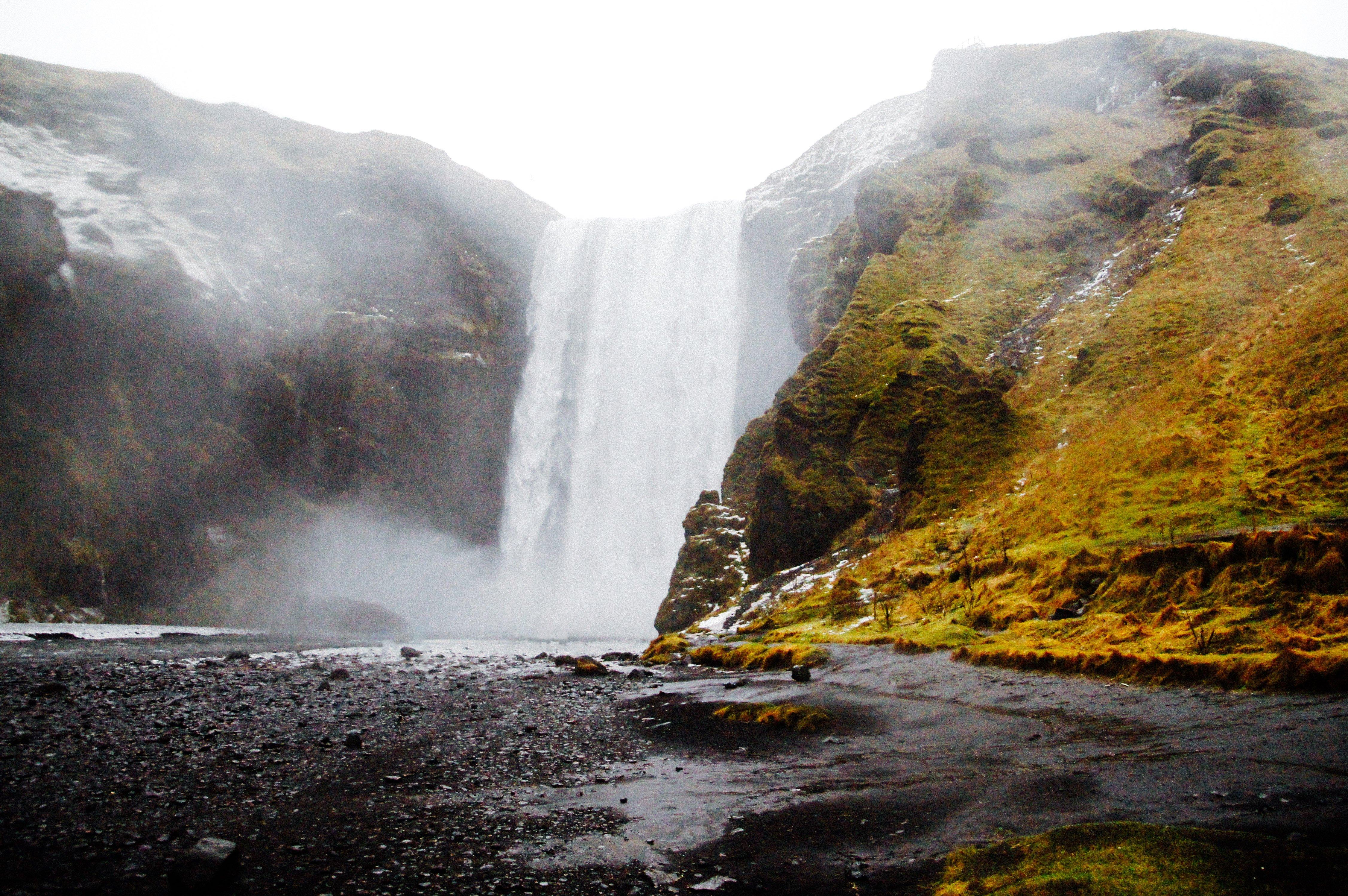
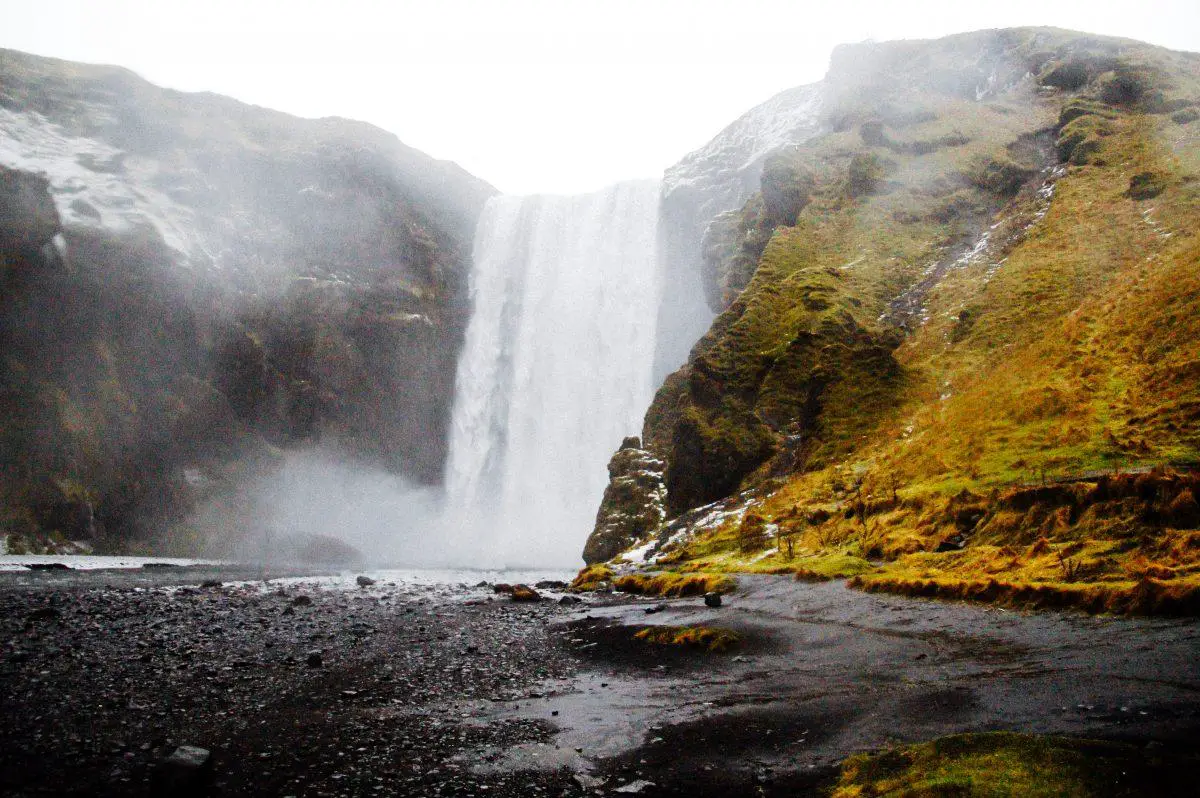
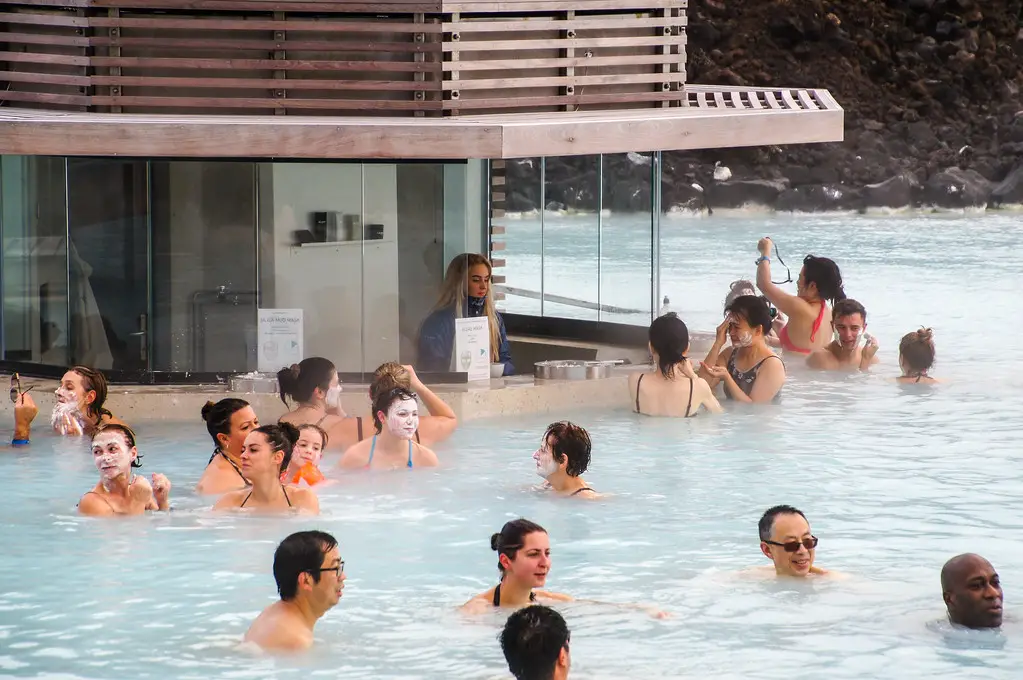




Stunning pictures and I always love a road trip. Driving in the south of Iceland is definitely an amazing adventure, and JOKULSARLON was the highlight of my roadtrip, and I saw the giant ice collapsed in front of my eyes! It was just incredible! @ knycx.journeying
Firstly let me say Brrrr it looks so cold but at the same time so beautiful, you photo’s took me right there! I would love to be able to stay in those little viking cottages, I have always been drawn to the viking era. You have really put a comprehensive guide together here with loads of info. Hope I get to Pscyh myself up one day to brave the weather and go visit Iceland.